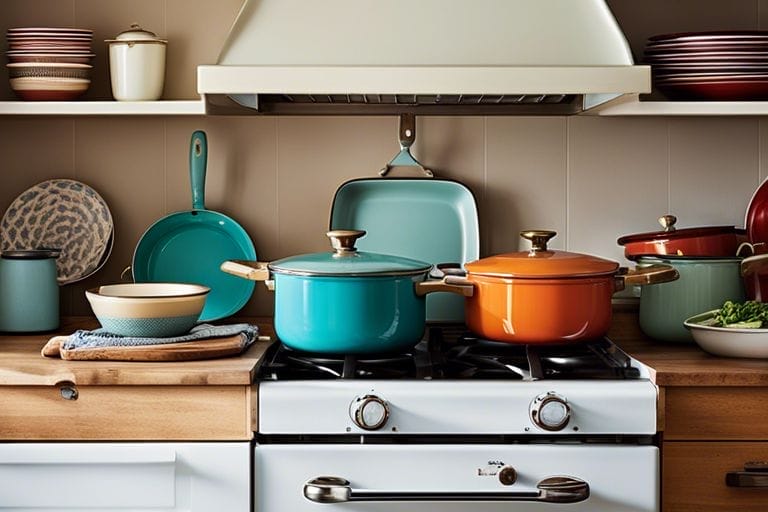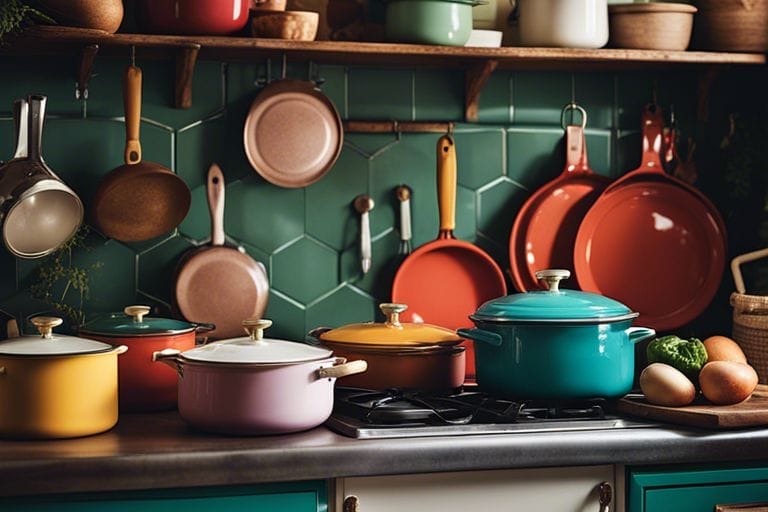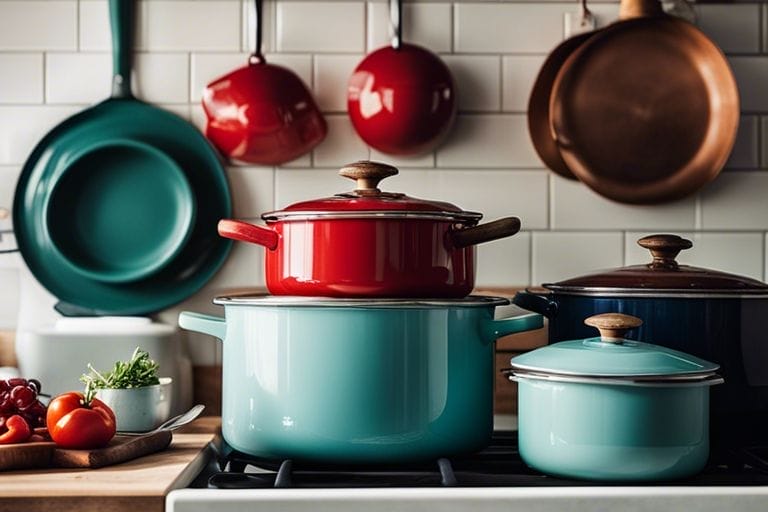Are you concerned about the safety of your cookware? When it comes to cooking with enamel, it’s important to understand the potential risks and benefits. Enamel-coated cookware can be a popular choice for its durability and non-stick properties. However, there are also concerns about the safety of enamel cookware, particularly when it comes to high heat and potential chemical leaching. In this blog post, we will delve into the safety considerations of cooking with enamel, evaluating the potential risks and providing tips for safe use. By the end of this post, you will have a better understanding of whether cooking with enamel is a safe choice for you and your family. So, let’s explore the safety of enamel cookware together.
Key Takeaways:
- Enamel cookware is generally safe to use: When used properly, enamel cookware is safe for cooking and is resistant to scratches and stains. However, it is important to avoid using metal utensils or abrasive cleaners to prevent damage to the enamel surface.
- Health concerns may arise from overheating and chipping: Enamel cookware can release small amounts of lead and cadmium if overheated or chipped. It is crucial to use enamel cookware within its recommended temperature range and inspect for any signs of damage before use.
- Proper care and maintenance are essential: To ensure the safety of enamel cookware, it is important to follow the manufacturer’s instructions for use and care. This includes avoiding extreme temperature changes, proper storage, and regular inspection for cracks or chips.

Composition of Enamel Cookware
Even though enamel cookware is a popular choice in many kitchens, there may be questions on its safety that you have. It’s important to understand the composition of enamel cookware and its potential impact on your health. You may have come across discussions like “Is this enamel pot still safe to use? : r/cookware” and wondered about the safety of your own cookware.
Materials and Manufacturing Processes
Enamel cookware is typically made from a base material such as cast iron or steel, which is then coated with a layer of enamel. The manufacturing process involves fusing powdered glass to the metal substrate through a high-temperature firing process. This creates a smooth, glossy finish that is not only visually appealing but also provides a protective layer against rust and corrosion. However, it’s essential to note that the quality of the enamel coating and the base material can vary between different manufacturers, so it’s crucial to choose reputable brands known for their high-quality construction and materials.
Chemical Properties and Potential Contaminants
Enamel cookware is generally considered safe for cooking, as the enamel coating creates a non-reactive surface that does not leach metals or chemicals into your food. However, you should be aware that low-quality enamel or enamel that has been damaged can pose potential health risks. Some enamel cookware may contain lead or cadmium, especially if manufactured in countries with less stringent regulations. Over time, the enamel coating can wear down, leading to potential exposure to these harmful substances. Additionally, acidic foods and harsh cleaning agents can accelerate the degradation of the enamel coating, increasing the risk of metal leaching. It’s important to inspect your enamel cookware regularly for any signs of chipping, cracking, or discoloration, as these could indicate compromised enamel that may pose a risk to your health.

Health Considerations for Enamel Cookware
Any time you are evaluating the safety of cookware, it’s important to consider the potential health implications. Enamel cookware is generally considered safe for cooking, but there are some factors to keep in mind to ensure you are using it correctly to minimize any potential health risks.
Leaching and Chemical Reactions During Cooking
When cooking with enamel cookware, you may be concerned about the potential for leaching of chemicals into your food. Enamel is typically a non-reactive material, which means it doesn’t release chemicals or interact with acidic or alkaline foods. However, if the enamel coating is damaged, there is a risk of metals like iron, nickel, or chromium from the underlying material leaching into your food. To minimize this risk, always inspect your enamel cookware for chips or cracks, and avoid cooking acidic foods for prolonged periods.
Temperature Tolerance and Risk of Chipping
Enamel cookware has a temperature tolerance of around 400-450°F, which means it is suitable for most stovetop and oven cooking. However, excessive heat can cause the enamel to chip, exposing the underlying metal. This can lead to potential health risks as metals can leach into your food. To minimize this risk, use low to medium heat settings and avoid using metal utensils that can scratch the enamel coating.
Leaching and Chemical Reactions During Cooking
| Enamel is typically non-reactive | Minimizes the risk of chemicals leaching into your food |
| Inspection is necessary for chips or cracks | Minimize the risk of metals leaching into food |
Temperature Tolerance and Risk of Chipping
| Enamel cookware tolerance of 400-450°F | Safe for most stovetop and oven cooking |
| Excessive heat can cause enamel to chip | Risk of metal leaching into food |
Comparing Enamel to Other Cookware Materials
Now, when it comes to choosing cookware, it’s important to consider the material it’s made from. Enamel cookware is just one of many options available to you. To make an informed decision, it’s essential to compare enamel to other commonly used cookware materials such as stainless steel, cast iron, and non-stick coatings. For a comprehensive guide on safe cookware options, check out this Safe Cookware Guide That Makes Sense.
| Material | Pros and Cons |
| Enamel | Durable and non-reactive, but may chip or scratch over time |
| Stainless Steel | Durable and resistant to staining, but may not distribute heat evenly |
| Cast Iron | Excellent heat retention and non-stick when properly seasoned, but requires regular maintenance |
| Non-Stick Coatings | Easy to clean and non-stick, but may release harmful chemicals when overheated |
Advantages of Enamel Cookware
Enamel cookware has several advantages that make it a popular choice. It is durable, non-reactive, and easy to clean. Additionally, enamel-coated cookware can come in a variety of vibrant colors and designs, making it a stylish addition to your kitchen. The smooth, non-porous surface of enamel helps to prevent food from sticking, making it easier to cook and clean up afterwards.
Limitations and Alternatives
While enamel cookware offers many benefits, it’s important to be aware of its limitations as well. Over time, the enamel coating may chip or scratch, potentially exposing the metal underneath. This could lead to the leaching of metals or unwanted flavors into your food. If you’re looking for alternatives, stainless steel and cast iron are both durable options that offer their own unique advantages. Stainless steel is non-reactive and resistant to staining, while cast iron provides excellent heat retention and can be non-stick when properly seasoned.
Best Practices for Using Enamel Cookware
To ensure the safety and longevity of your enamel cookware, it is important to follow some best practices for usage. By doing so, you can maximize the benefits of using this type of cookware while minimizing any potential risks.
Maintenance and Care
Proper maintenance and care of your enamel cookware is essential to ensure its safety and longevity. Always use non-abrasive cleaning products and utensils to avoid scratching the enamel surface. Additionally, avoid sudden temperature changes, such as placing a hot pot in cold water, as this can cause the enamel to crack. When storing your enamel cookware, make sure to stack it carefully to prevent any chipping or damage to the enamel coating. By following these maintenance and care guidelines, you can ensure that your enamel cookware remains safe for use for years to come.
Guidelines for Safe Cooking
When using enamel cookware, it is important to follow certain guidelines to ensure safe cooking practices. Always use wooden or silicone utensils to avoid damaging the enamel coating. Additionally, avoid cooking acidic foods for prolonged periods of time, as this can cause the enamel to wear down. It is also important to avoid using high heat settings, as this can cause the enamel to deteriorate. By following these guidelines for safe cooking, you can ensure that you are using your enamel cookware in the safest and most effective manner.
Is Cooking with Enamel Safe? Evaluating Cookware Safety
Drawing together all the information presented in this evaluation of cookware safety, it is clear that cooking with enamel can be safe as long as you use it properly and maintain it well. Enamel cookware, when properly manufactured and used according to the manufacturer’s instructions, can provide a safe and effective way to cook your meals. It is important to be aware of any potential issues such as chipping or cracking, as well as avoiding cooking at excessively high temperatures, to ensure the safety and longevity of your enamel cookware. By following these guidelines, you can confidently and safely cook with enamel in your kitchen.
FAQ
Q: Is cooking with enamel safe?
A: Yes, cooking with enamel-coated cookware is safe. The enamel coating creates a barrier between the food and the metal, making it a safe option for cooking. However, it is important to use enamel-coated cookware properly to avoid damage to the enamel and ensure safety.
Q: What are the benefits of cooking with enamel-coated cookware?
A: Enamel-coated cookware offers several benefits. It is non-reactive, meaning it does not leach chemicals into the food. It is also easy to clean and can be used for a variety of cooking methods, including baking and roasting. Additionally, enamel-coated cookware is available in a wide range of colors and designs, making it a stylish addition to any kitchen.
Q: How can I ensure the safety of my enamel-coated cookware?
A: To ensure the safety of your enamel-coated cookware, it is important to follow the manufacturer’s instructions for proper use and care. Avoid using metal utensils that can scratch the enamel, which may lead to leaching of metals into the food. Additionally, be cautious when cooking over high heat, as excessive heat can cause damage to the enamel coating. Regularly inspect your enamel-coated cookware for any signs of wear or damage, and discontinue use if the enamel is chipped or cracked.

